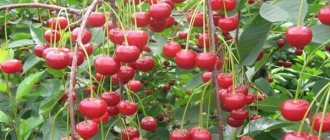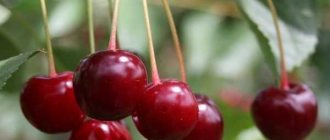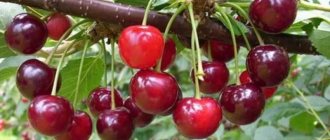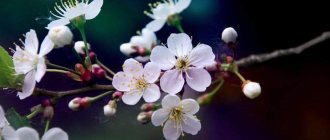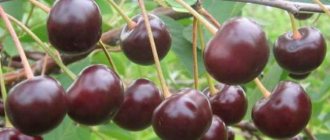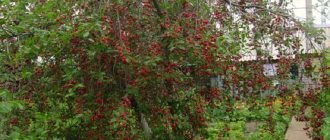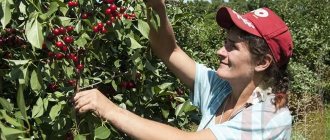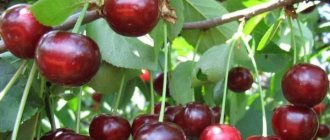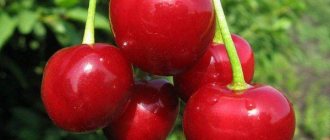Cherry Michurinskaya
Cherry is a fruit and berry tree.
Its fruits are red in color, sweet and sour in taste, they contain vitamins A, B and C, as well as a lot of iron and folic acid. Cherries come in yellow, pink and red colors. Taste and color depend on the variety. Let's take a closer look at the features of Michurinskaya cherries, the description of the variety and its characteristics. Cherry Michurinskaya was bred at the Scientific Institute named after I.A. Michurin by A.V. Morozova in 1994.
Fertile cherry Michurina was obtained as a hybrid of cherry and sweet cherry. Another name for the hybrid is Michurinka cherry.
Description and characteristics of the variety
Frost resistance
This cherry tolerates low temperatures well, it can be planted in the middle zone, but in Siberia and in the northern regions the trees will require insulation.
Productivity
The variety is very productive, you can get about 100-150 c/ha. From 1 tree you can get up to 65 kg of berries. The tree begins to bear fruit 5 years after planting. This cherry is a late ripening one. For example, in Michurinsk they begin to pick cherries from mid-late July.
Important! This cherry is self-sterile. This means that it will not produce a harvest on its own. It is obligatory to plant such varieties of cherries as Pink Pearl and Michurinka nearby. These are pollinators.
Bloom
The flowers are white, slightly pinkish, large, and have a pleasant aroma. The inflorescence consists of 3 flowers. The plant looks very decorative during the flowering period. It blooms at the end of June.
Tree options
It is medium-sized, the crown is round-oval, the bark is brown, the shoots grow straight, the buds are oval. The leaves are bright, dark, green, smooth, oval-shaped, narrow, jagged.
Fetal parameters
The berries are heart-shaped, wide, dark red in color. The weight of 1 cherry is about 7 grams. They are juicy, sweet, with a slight sourness. The stone is easily separated from the fruit, smooth, round. The skin is dense. The stalk is thin, short and the fruits are easily removed from it.
On a note! The fruit contains almost 13% healthy sugars, almost 10 mg of ascorbic acid per 100 g of berries and 0.5 acids.
Planting seedlings
Separate holes are prepared for each individual seedling of late Michurinskaya cherry. The diameter of each must be at least 60 cm. The depth of the planting hole must be at least ½ meter.
A mixture is poured into the bottom of the pit, which consists of:
- humus;
- turf;
- sand.
All components are taken in equal parts. Superphosphate and potassium chloride are also added.
The hole should be 2/3 full. Be sure to water the soil abundantly. A peg is driven into the center for support.
The seedling is placed in the prepared hole. The roots are straightened out as much as possible. Next, sprinkle with earth without burying the tree.
A depression is made around the Michurinskaya trunk and at least ten liters of water are poured into it. It is better to use settled and warm water.
Afterwards the young tree is pruned. The shoot should be no more than 60 cm in height.
Planting scheme
When planting Michurinskaya cherries, the holes for seedlings are placed at a distance of at least five meters from each other. This is done so that mature trees do not interfere with or shade each other.
Disembarkation period
It is recommended to plant cherry seedlings in the spring, when the soil is sufficiently warm.
If you plant a tree in the fall, it will not have time to get stronger before the onset of cold weather and frosts. The seedling will die.
Agricultural technology and care
The planting site should be sunny and protected from drafts.
Attention! It is impossible for cherries of any variety to once grow in the place where the Michurinskaya cherry is supposed to be planted.
Seedlings are selected without damage, with brown roots and moist.
14 days before planting seedlings, you need to fertilize the soil. Cow dung and bird droppings are used for this. After applying fertilizers, the soil is dug up.
The trees are planted in holes measuring 60 cm (width) by 50 cm (depth). Sod, humus and sand are poured into the bottom.
The hole is filled with water, a seedling and a support for it are installed. Trees are planted 5 meters apart. Planting is carried out in early spring so that the seedlings have time to take root before winter.
Attention! When the tree is planted, you need to make a hole around it and pour about a bucket of water (10 liters) into it.
The bush also needs to be formed. To do this, when the plant reaches 60-70 cm in height, the branches are shortened; if there are sick and dry ones, they are also cut off. This procedure is necessary for proper crown growth and to reduce the density of branches and leaves.
Reproduction occurs by cuttings. You can also graft it onto varietal cherries. For example, to Vladimirskaya.
Preparing the planting hole
The size of the planting space for cherries depends on the variety and condition of the soil on the site. For large trees, you need to dig holes 1 m wide and long and 60 cm deep. Such dimensions are necessary for varieties that grow over 5 meters in height.
These include:
- Wreath
- Star
- In memory of Vavilov
- Griot Seridko
- Toy
- Lutovka
- Shpanka and its hybrids – Early spanka, Large spanka
Vavilov memory variety
The larger the above-ground part of the tree, the more powerful the root system.
Medium-sized hybrids will need a seat 0.7 m in diameter and 0.5 m in depth. The following varieties are fully satisfied with these conditions:
- Griot Ostheimsky, 3 m high
- Optimist - above average size, but smaller than large cherries
- Miracle cherry
- Minx
- Elegant
Variety Shalunya
The roots of low-growing cherries can be content with a space of 0.5 m in width and length and the same in depth. Representatives of this group will especially please owners of small plots:
- Nord Star, height 2 – 3 m
- Meeting – 2.5 m
- Lyubskaya – 2 m
- Molodezhnaya – 2 – 2.5 m
- Chocolate girl
Sotr Lyubskaya
Bush cherries are planted in holes 30 cm x 30 cm x 30 cm:
- Zhukovskaya
- Generous
- Irtyshskaya
- Subbotinskaya
- Altai swallow
- Bolotovskaya
Variety Altai swallow
If the soil on the site is cultivated for a vegetable garden, in a layer of 25 - 30 cm, then when digging a hole, the top layer on the spade bayonet is put aside separately. The land, which is deeper, is subject to optimization; it is selected to the desired depth and located separately.
Then, add improving additives and mix thoroughly. When planting, return to the prepared hole. In cases where the natural soil is infertile, it is completely dug up and replaced with imported or pre-optimized soil.
Building a garage with your own hands: details about each stage. Description, step-by-step instructions, drawings of the roof, inspection pit, interior arrangement (75 Photos & Videos) + Reviews
Tree care
This cherry is unpretentious, so care involves simple procedures.
The plant needs watering 2 times per season. During the flowering and fruiting period (but you cannot water the plants 30 days before picking the berries).
Mulching is necessary to avoid excess moisture and facilitate air penetration into the soil. Mulching is done with hay, straw, peat, and crushed stone. Everything needs to be laid around the trunk, so as to avoid contact with it. The layer must be at least 6 cm thick.
Be sure to fertilize. They, like watering, are necessary only when the plant blooms and bears fruit. You need to feed with a solution of 1 bucket of manure, 4 buckets of warm water and 1 kg. wood ash.
Important! The solution should be kept in a warm, dark place for 2 weeks.
Next, fertilizing is done at the rate of half a bucket per plant. Other fertilizers useful for Michurinskaya cherries:
- Potassium salt. Used to improve the land. Potassium salt will also speed up growth and increase yield. Fertilizer is applied in an amount of about 5-6 g. It is better to do this in early spring or autumn.
- Superphosphate. This is a fertilizer rich in phosphorus. It is applied in the fall, when digging up the ground. This fertilizer stimulates metabolism and improves fertility.
- Ammonium nitrate. It is necessary to increase the amount of nitrogen in the soil. Apply in spring.
In the spring and after picking berries, branches are pruned. Remove dry, broken, diseased branches.
Rules for planting cherries
Planting is carried out on a cool day with an air temperature of about +5...+10°C. If frost is expected, postpone planting until the next day. Do not expose roots to low temperatures.
Landing dates
Planting is carried out in early spring or autumn, until the end of September. But most often it is planned for April. This will give the tree the opportunity to prepare well for winter and take root.
Important! The leaves of the Rosaceae, to which the cherry belongs, are moderately poisonous, so they should not be consumed in large quantities.
Choosing a landing site
The planting site should be sunny, with well-drained soil. It is advisable that the sun illuminates it for at least 6 hours a day
This is important, since both the sweetness of the fruit and the volume of the harvest depend on the sun. Drainage is essential because tree roots cannot absorb nutrients when they are in constant contact with water.
If the area is clayey, the soil is diluted with sand. Some gardeners also practice raised bed planting - this is planting in a box without a bottom, which is made of wood or other sheet material. It prevents soil erosion and the crumbling of such a bed. On sandy soils the tree will suffer from drought. Such soil can be improved by adding clay. The preferred soil acidity is from 6.0 to 7.0 pH. When inspecting the site, make sure that you have enough space to plant 2 trees, and also that the tree will not be interfered with by obstacles above or below in the form of various communications, irrigation systems and other objects.
Find out in more detail how to properly plant cherry seedlings in spring and autumn.
Preparing the landing site
It is believed that planting holes can be prepared in the fall and planted in the spring. Humus (10 kg) or other organic matter is poured into the autumn pit and left until spring. But this approach also has opponents who believe that during the winter, organic matter manages to release nutrients into the soil, which will be washed away by melting snow into the lower layers of the soil and will not be absorbed by the tree. Potassium (about 60 g) and phosphate fertilizers (about 100 g) are also added to the pit. Potassium is necessary for organizing intracellular metabolism, and phosphorus is necessary for the development of the root system and fruiting.
Direct landing
The seedling received from the nursery usually has empty roots, so they are soaked in water for 1–2 hours before planting. Then the roots are dipped in clay mash to protect them from contact with soil fungi.
Clay mash for the root system
Planting technology:
- Dig up the area and prepare planting holes. Depth - about 0.5–0.6 m. Width - 2 times the depth. But at the same time, try to focus on the size of the root system - the hole should be slightly larger than it.
- Mix 1 bucket of rotted manure with soil in the following ratio - 1/3 organic matter and 2/3 soil.
- Place the cherry in the center, straightening the roots.
- Place a peg nearby to tie the tree - this will give it stability.
- Fill the hole, moving from the edges to the center. Compact it as you fall asleep.
- Pour in 1-2 buckets of water when you fill the soil to the middle.
- Make sure that the junction point between the scion and rootstock is 5–7 cm above the ground.
- Spread the soil evenly around the cherry tree.
Diseases and pests
The variety is resistant to many diseases, but is susceptible to two: coccomycosis and moniliosis (monilial burn).
The first disease appears as small red spots on the leaves on one side and gray pads on the other. These pads contain fungal spores. Damaged leaves fall off. To treat the disease, it is necessary to treat the tree with Bordeaux mixture and fungicides with copper. To prevent the plant from becoming infected, carry out preventive measures. It involves removing and burning fallen leaves and digging up the soil around the tree.
The second disease is expressed in drying of leaves, shoots, fruits, and ovaries. First of all, you need to remove (burn) all infected elements of the plant. Next, you need to spray the tree with Zircon or use products with sulfur and copper for treatment.
The only pest that can ruin the harvest and the plant itself is the cherry weevil. It penetrates the berries, infects them and lays larvae there. If you do not get rid of the pest, you can lose the entire harvest; the cherry weevil multiplies quickly. Prevention and treatment consist of spraying with insecticides. This is done 2 times: during the swelling of the buds and during flowering. You also need to dig up the soil.
Important! All diseased parts of the plant must be removed and burned! This is necessary so that the plant does not become infected again and does not infect its neighbors in the area.
Digging the soil helps get rid of many pests and prevents a number of diseases. It is good to use special preparations when digging, including biological stimulators of plant growth, development and fruiting, for example, Epin.
Preparing cherries for winter
A long winter period is a serious test for a heat-loving crop. Without shelter and preparation, the cherry tree will not withstand frost and will die. Therefore, already in August they begin to prepare plantings for wintering.
Main events:
- bending tree branches to the ground. In this form it is easier to cover plantings before cold weather;
- timely pruning of cherry shoots and growths;
- removing the top shoots if they are not ripe. The degree of ripening is determined by lignification; it is necessary that the shoots leave in winter strong and lignified. Pinching (pinching) speeds up the process and increases the tree’s resistance to frost;
- spraying (defoliation) of leaves if they have not fallen by mid-September. A solution of iron sulfate or urea is used, which accelerates leaf fall and the formation of flower buds.
Trunks and branches of trees that are not going to be bent down are whitened with indelible compounds. Clay, a mixture of hot pepper, and mullein are added to ordinary lime. Whiten after the leaves fall.
Features of the variety
The variety combines the qualities and benefits of cherries and sweet cherries, and was obtained from yellow cherry varieties using special processing. It has virtually no flaws.
Note! A variety of Michurinskaya cherry is Griot Michurinskiy cherry.
Its berries are smaller (about 4-5 grams). But they are similar in composition: about 12% healthy sugars, 2% ascorbic acid and 33 mg of ascorbic acid per 100 grams of fruit. The berries of both varieties also contain fructose, glucose, vitamins A, B, C, a lot of iron, as well as amino acids.
This variety is used more for technical processing than for fresh consumption. This is due to the size of the fruit and its taste characteristics. But this variety is excellent for preparing and preparing various dishes.
By the way, the Griot Michurinsky variety has other pollinators: Zhukovskaya, Molodezhnaya, Tamaris, Turgenevka. In addition, this variety is partially self-fertile. But you need to take into account that the yield will be low without pollinators. Griot's yield is slightly lower.
As you can see, the Michurinskaya and Griot Michurinsky cherry varieties are very similar, but there are differences between them.
Advantages and disadvantages of the variety
Cherries of this variety have many more advantages than disadvantages. That is why it has become so widespread among gardeners throughout Russia.
Advantages:
- Taste and quality of fruits. They are large, dark red, sweet, and versatile in use. The berries are consumed fresh, canned, made into jam, and dried. Another feature of this cherry is that the fruits do not fall off the branches when ripe. This cherry is fertile, you can harvest up to 80 kg from it.
- Michurinskaya cherry is frost-resistant and unpretentious.
- The variety is resistant to a number of diseases and is not susceptible to attacks by many pests.
- The plant regularly produces abundant harvests.
- The berries are well stored and preserved during transportation.
- The variety is undemanding to soil.
Flaws:
- The tree is not self-fertile. If pollinators of certain varieties are not planted nearby, there will be no fruit.
- Low life expectancy of the tree. It lives and bears fruit for no more than 20 years. To obtain a continuous regular harvest, it is better to plant several trees of different ages on the site at once.
Michurinskaya cherry variety is an excellent choice for almost all regions. It is large-fruited, sweet, and is excellent for both harvesting and fresh consumption. The tree itself will not take up much space due to its compact oval-shaped crown.
Harvest
Harvesting of Shchedraya cherries should begin at the first appearance of ripe fruits - otherwise they will attract birds and insects to the tree, which also like to eat the crop. You can verify the ripeness of the product by picking 1 berry: it should have a characteristic sweet-sour taste, and the pulp in your mouth should be easily separated from the seed. The shade of ripe berries should be burgundy, characteristic of this variety. It is necessary to pick cherries in dry and sunny weather, preferably in the morning, after the dew has disappeared.
For food consumption, you can pick fruits without stalks; the shelf life of such berries will be up to 48 hours. To store for 3 weeks, cherries should be collected in large wicker baskets lined with paper, and always with stalks - then the fruits will not rot and release juice. Baskets with cherries must be placed in a cool and dark room with a temperature of +4°C to +7°C, and the humidity should be 80%.
Important! Cherry fruits are not able to ripen after being picked from the branch, so they should be picked only after full ripening. The Schedraya cherry tree variety is very attractive to gardeners in the northern regions, as it tolerates cold well.
And thanks to their short stature, the trees are easy to care for and harvest ripe crops
The Shchedraya cherry tree variety is very attractive to gardeners in the northern regions, as it tolerates cold well. And thanks to their short stature, the trees are easy to care for and harvest when ripe.
Origin of the variety
The birthplace of “Griot Michurinsky” is the Tambov region, where the All-Russian Research Institute of Horticulture named after. I.V. Michurina. Employee of this scientific institution Morozova T.V. carried out an experimental treatment of cherry seeds of the ancient Spanish variety “Griot Ostheimsky”, known since the end of the 18th century. During the experiment, the germinated breeding material was treated with substances that cause mutations in the plant body - chemical mutagens (NEM mutagen). Since 1994, the hybrid obtained as a result of breeding work has been undergoing state variety testing.
Cherry “Griot Michurinsky” - description and characteristics
Cherry trees of the “Griot Michurinsky” variety are characterized by medium growth and the presence of a sparse, rounded crown consisting of raised branches. The main fruit formations are bouquet branches. The trunk of the tree and skeletal branches are covered with brown bark. Compact shoots are covered with light brown bark with a few lentils. The leaves are medium in size and narrowly oval in shape. Their smooth, glossy surface is painted dark green, and there is no edge on it. The contours of the leaf plates are usually jagged: the teeth are rounded and alternate with pointed grooves of different sizes. The leaves are attached to the shoots by petioles of medium length and thickness, colored in purple tones. Small stipules have a weakly dissected structure and quickly fall off. During the flowering period, the shoots of trees of the “Griot Michurinsky” variety are covered with medium-sized horn-shaped flowers with rounded petals, painted white. They are characterized by a short flowering period.
The fruits of the “Griot Michurinsky” variety are above average in size, their weight is about 4-4.5 g. They have a round shape with a small depression at the base and small dimensions of the ventral seam. The apex of the fruit is also rounded. The medium-sized stalk is easily separated from the branch and has a weak connection with the seed. The surface of the fruit is dark red and has no cover points. The seeds are characterized by small sizes; they, as a rule, have a round shape and a smooth surface, and are easily separated from the fibrous part of the fruit.
The pulp of the fruits of the “Griot Michurinsky” variety is dark red in color and has medium density and is saturated with a large amount of juice of the same shade. Its flavor bouquet is predominantly sweet with sour notes. The chemical composition of the fruit pulp of “Griot Michurinsky” includes a lot of sugars (about 12%), acids (1.3%), vitamin C (32 mg per 100 g). The fruits of this variety have a technical purpose and serve as raw materials for the production of juices, compotes, preserves, and jams.
Consumer goods black
An excellent tasting variety. Bred by I.V. Michurin.
A medium-sized tree with a rounded crown. The fruits are large, black, flat-round in shape. The pulp is dense and very tasty. The juice is colored. The fruits ripen in the first half of July. Winter hardiness is average; in severe winters, branches and flower buds freeze. The fruiting period begins in the 4th-5th year, the yield is good. Zoned in the central regions of Russia, in the Lower Volga region, Polesie, in the steppe part of Ukraine and in Latvia.
Cherry “Griot Michurinsky”: features of the variety
“Griot Michurinsky” is classified as a partially self-fertile cherry variety, and therefore requires the presence of pollinating trees on the site. The optimal choice for this purpose would be pollination by “Tamaris”, also bred by T.V. Morozova, “Turgenevka”, “Zhukovskaya” and “Molodezhnaya”.
The first fruiting of “Griot Michurinsky” occurs in the 4-5 season of tree growing. The variety belongs to the mid-season: the phase of removable fruit ripeness in the Tambov region begins after July 10 and lasts until the end of the month. This variety is characterized by regular harvests; on average, 6 to 8 tons of fruit are collected from 1 hectare under the conditions of the region of its origin. Cherries of the “Griot Michurinsky” variety tolerate transportation well, while maintaining their commercial qualities.
Reproduction of "Griot Michurinsky" is carried out by budding: for this purpose, seedlings of cultivated varieties of cherries, as well as clonal rootstocks of "Vladimirskaya" cherries are used. One of the important procedures for caring for trees of the “Griot Michurinsky” variety is pruning - it is carried out in cases where the crown of the plant becomes too thick. First of all, it is necessary to remove the branches of the lower tiers and all dry and non-viable shoots. Next, part of the main shoot is cut off so that the tree does not grow too tall - this will make harvesting easier. In addition, shoots growing inside the crown and branches that are too densely spaced are removed. This will allow the remaining branches and the fruits ripening on them to receive the necessary amount of sunlight.
Characteristics of the tree and fruits
A medium-sized tree with brown bark grows quickly, its round-oval (or wide-pyramidal) crown is slightly raised, it is made up of thick, straight, hairless shoots with a small number of lenticels. The buds deviate greatly from the shoots. The smooth, dark green leaves have a narrow oval shape and jagged edges. The white, pink-shaped flowers are much larger than those of the cherry; one inflorescence contains 2–3 flowers. The fruits are formed on bouquet branches of different ages.
The fruiting dates indicated in the official description are valid for Michurinsk. They may vary slightly depending on the region, but they still arrive late (later even than such a well-known variety as Bryanochka). One mature tree produces up to 60 kg of berries. The berry is large, fleshy (average weight 5.5–6.5 g), has a beautiful dark red color of dense skin with a barely noticeable seam and a heart-shaped shape. The flesh is also red, juicy, the stone is smooth, oval-shaped, easily separated.
The taste is sweet with barely noticeable sourness. The berries are universally used; they are very good fresh, can be stored for several days and are easily transported. They are frozen and canned for the winter, and they are used to make delicious jam.
Caring for late cherries is somewhat different from caring for early varieties. This is explained by the fact that fruits take much longer to form, using much more resources.
Annual pruning is carried out in the spring. The first few years it is aimed at forming the crown in tiers - this makes it easier to care for the tree. Further pruning is of a sanitary nature. It is advisable to treat the places of all cuts and cuts with garden varnish.
Cherries love moisture. Michurinskaya late is watered once every month, but abundantly: a young tree needs 3-4 buckets of water, and a fruit-bearing tree needs a couple of buckets more. When the fruits have already grown and are actively turning red, it is better to postpone watering so that the berries do not crack.
Cherries are planted in a permanent place in the spring, and the pit is thoroughly filled with organic and mineral fertilizers in the fall. In the second year of growth, you can already apply fertilizing. They usually start with urea, which will need no more than 200 g per 1 square meter. m of tree trunk circle. In the third year, organic and mineral fertilizers are applied. Organic matter, as a rule, is applied every 2-3 years, but mineral fertilizers are added annually - urea in the fall, and superphosphates in the spring.
Bagryannaya
Among the new cherry varieties, the Bagryannaya variety is also of interest. The parents of the new product are the well-known varieties Vladimirskaya and Shubinka. The variety is valued for its early fruit ripening: the harvest ripens seven to ten days earlier than the Vladimirskaya variety. And it’s especially nice to taste the early harvest. The fruits of the variety are large, beautiful dark red in color.
Read more: Bronchopneumonia of calves: what it is, how to treat it
The variety bred by Michurin, Vole, is distinguished by its unpretentiousness. It produces abundant, lush growth, so it can be planted to strengthen ravines and create hedges. Small vole bushes are abundantly strewn with juicy, pinkish-red fruits. The variety is high-yielding, begins to bear fruit early, and is winter-hardy.
Advantages and disadvantages
The advantages of the variety, in addition to its late ripening period, are the high taste of the fruits, their visual attractiveness and the ability not to fall off the branches after ripening. An important advantage is the regularity of rich harvests and good tolerance of cold weather. The variety is also valued for its resistance to fungal diseases and pest attacks.
But the disadvantages include the non-self-fertility of the variety and the short life span of the tree. Replacing a tree in 10–15 years will lead to the obligatory purchase of a seedling or the hassle of growing a seedling and budding a shoot from an old tree.
